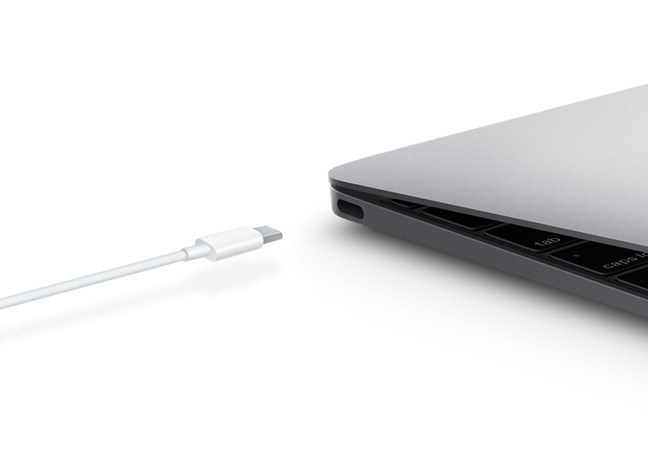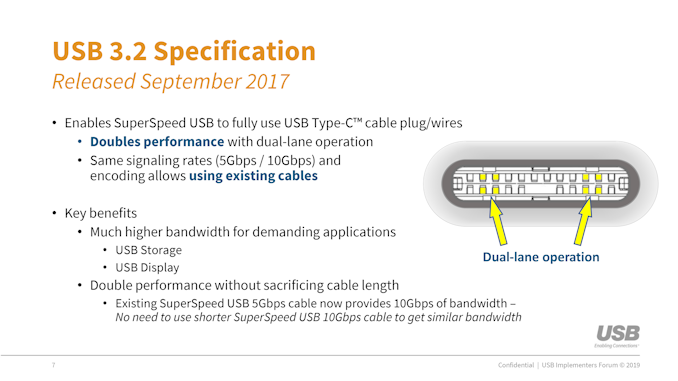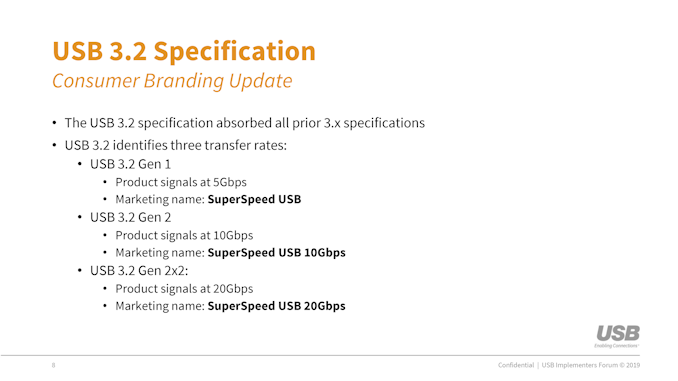USB 3.2 at 20 Gb/s Coming to High-End Desktops This Year
by Anton Shilov on February 26, 2019 1:00 PM EST- Posted in
- Peripherals
- Trade Shows
- USB-C
- USB
- ASMedia
- USB 3.2
- MWC 2019
- Synopsys

Since mid-2017 we've been talking about the impending arrival of USB 3.2, the next version of the USB Implementers Forum's ubiquitous standard for connecting external devices. With 3.2 serving as both an upgrade to the feature set and a physical layer tweak to provide more bandwidth, according to the USB-IF at MWC 2019, the technology will finally come to fruition this year.
According to the organization that sets the standards for the USB interface, discrete USB 3.2 controllers capable of supporting the standard's new 20 Gb/s Type-C mode will be available this year. Being a specification-setting group, the USB Implementers Forum does not name companies that develop actual chips. But given the limited number of companies that develop standalone USB controllers, the names of the suspects are pretty well known.
Since discrete USB controllers are used mostly by high-performance desktop systems, we're likely to see the first USB 3.2 chips to land on high-end motherboards first. In which case we could see motherboard venders showing off product sometimes this summer, or maybe a bit later. Meanwhile peripherals will likely lag a bit for compatibility testing and the like, in which case we'd start seeing them in 2020.
Though technically only a point upgrade for the USB standard, USB 3.2 includes multiple enhancements for the standard in terms of bandwidth, as well as changes to how the standard is branded. In terms of bandwidth, USB 3.2 introduces the ability to use two high-speed USB Type-C Tx/Rx channels – the so-called x2 mode – to get 20 Gbps maximum throughput on a Type-C cable. The technology retains the USB 3.1 physical layer data rates and encoding techniques (SuperSpeed and SuperSpeed+), so while bonding two channels is new, how those individual channels work at a low-level is not.
Meanwhile, USB 3.2 branding will be absorbing the earlier USB 3.0/3.1 branding, as the overriding USB 3.x standard continues to evolve separately of the underlying SuperSpeed encoding technique. As USB 3.2 hosts and devices roll out on the market, we’ll see the branding switch over to USB 3.2 Gen 1 (5Gbps SuperSpeed), USB 3.2 Gen 2 (10Gbps SuperSpeed+), and USB 3.2 Gen2x2 (2x10Gbps SuperSpeed+). So while all future products will be 3.2, they won't necessarily support the higher 10Gbps and 20Gbps data rates. Those decisions are up to the device manufacturer, especially as not all devices need the higher speed modes and the increased build costs that come with them.
Related Reading:
- ASMedia Demos USB 3.2 Gen 2x2 PHY, USB 3.2 Controller Due in 2019
- USB 3.2 Update to Bring 20 Gbps Bandwidth: USB 3.1 Type-C Cables Compulsory
- Cosemi Launches USB 3.1 Gen 2 Hybrid Active Optical Cable: Up to 50 Meters of USB
- Cypress and Zhaoxin Have USB 3.1 Gen 2 USB Controllers
Source: USB Implementers Forum












62 Comments
View All Comments
ksec - Tuesday, February 26, 2019 - link
That is why since 2017 I have been advocating a new Standard, Call it USB 4.0 and requires Type-C Connector, no more SuperSpeed+ Cable, all USB 4.0 Cable should be SuperSpeed+ capable. Only differentiate them when it is necessary such as 100W charging vs normal Sub 50W charging. ( Which requires changes to thickness of cable )jordanclock - Wednesday, February 27, 2019 - link
The only change I can see in 3.2 to come close to justifying all of this is that 3.2 adds a new mode for 10Gb using 2 channels with 8b/10b encoding (USB3.2 Gen1x2). 3.1 does 10Gb with 1 channel on 128b/132b encoding(USB3.1 Gen2 OR USB3.2 Gen2x1). But I can't really say that's a good reason to add another point release and yet more confusion.name99 - Wednesday, February 27, 2019 - link
Even that is dumb.USB5
USB5C
USB10C
USB20C
HStewart - Wednesday, February 27, 2019 - link
Can Type A adapters even do 10 Gbps - surely can't do 20Gbps or 40Gbps (TB3) so I think they need to keep support Ledgecy Type A adapters and that is why they have Gen 1/2/3 specsJust get TB3 and forget this older stuff. And use adapters for old connections.
peevee - Tuesday, February 26, 2019 - link
3.1 Gen2 should have been USB4.3.2 Gen 2x2 should have been USB5.
But marketoids... why people who fail primitive school-level math and science are allowed to make ANY decisions is a WTF.
The Benjamins - Tuesday, February 26, 2019 - link
the naming sceam of USB isn't made by marketing people, but engineers. small speed steps are 0.X, big speed steps are X.0.The "2.0", "3.0", "3.1" are revision levels, the marketing terms is SuperSpeed USB (5Gbps), SuperSpeed USB 10, SuperSpeed USB 20
Santoval - Tuesday, February 26, 2019 - link
USB branding is already a mess, yet USB-IF instead of simplifying it wants to screw it up even further and expand the "retroactive rebranding" they started with USB 3.0 (which was retroactively rebranded to USB 3.1 Gen 1). Are these guys completely detached from reality or do some of their member companies push for crap like this?A5 - Tuesday, February 26, 2019 - link
USB-IF is an industry group run by and for its members, not general consumers.It is safe to say that this decision is driven by the marketing groups at the member companies, and not anyone with common sense.
ksec - Tuesday, February 26, 2019 - link
This article make it as if USB 3.2 is just announced while stating the spec was released in 2017.In reality all there is new is that they decide to depreciate all USB 3.0 and USB 3.1 into USB 3.2
The good thing is now we can all just use USB 3.2 label, and it will always be a Type-C connector since USB 3.2 does not support any other connector. The bad things is that you have to be aware of what variant of USB 3.2 you are getting at, and we may very likely end up having USB 3.2 cable that does not support 20Gbps.
What a bloody mess.
ksec - Tuesday, February 26, 2019 - link
OK turns out you can still have USB-A Port with USB 3.2, so technically only USB 3.2 Gen 2x2 requires USB-C Port.Yeah, and people are crying over iPhone should switch to USB-C port.